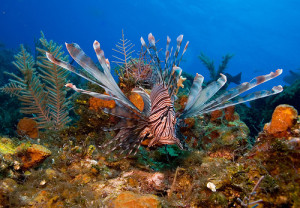Lion fish hunting activity for home
by Jillian Browning • July 4, 2014 • Announcements, Education
You will need
- Two forks

- A4 coloured paper
- Ruler
- Pencil
- Scissors
- Sticky tape
- Six grapes
- Cutting board or large plate
- A partner
What to do
1. Using the ruler and a pencil, draw a line seven centimetres from the long edge of the piece of paper.
2. Cut along the line so you have a strip of paper.
3. Take the strip of paper and fold it in half and half again to make a square.
4. Unfold the strip of paper. The paper will have creases where it was folded.
5. Take one square of paper. Fold a one centimetre strip along one edge, and turn the paper over. Then fold one centimetre from the last fold. You are making a zig-zag, accordion-style fold (like a fan). Each fold should be about one centimetre wide. Keep turning the paper over and folding until you reach the other edge of the paper.Cut along the creases so you have four squares of coloured paper.
6. Use sticky tape to cover one end of the folded paper, just enough so that the sticky tape holds the folds together.
7. Spread out the other end of the folded paper, so it looks like a fan.
8. Repeat step 5 to 7 for the three other squares of paper.
9. Put a fork on the cutting board so the fork is upside down with the points pointing away from you. Take a paper fan and tape the sticky-taped end to the fork, about a centimetre from the points of the fork, so the fan points left. Now, tape a second fan to the right. The fans and fork should make a T-shape, but with the points of the fork sticking out above the T.
10. Repeat step 9 for the second fork.
11. The forks will be our lionfish, and the paper fans are their fins. The lionfish are going to hunt grapes on the cutting board. The lionfish catches a fish when the fork sticks into a grape.
12. Put six grapes on the cutting board.
13. First, try hunting with just one ‘lionfish’. Use one fork and try to stick the fork in the grape. You must ‘swim’ towards the ‘fish’ from the side – you can’t stab downwards.
14. It’s quite tricky with just one ‘lionfish’, so see if it’s easier with a friend. Give your partner the other fork, and see if you can work together to stick the forks in the grapes. Remember that you have to ‘swim’ towards the grapes, not stab downwards. Take turns so both ‘lionfish’ have a chance to catch the ‘fish’.
What’s happening?
It’s tricky to spear a grape with just one fork because it takes some force to push the points through the outside of the grape, and the grape keeps rolling away! Having a second fork gives you something to push the grape against. Lionfish hunt in groups so they can use their long side fins to herd prey into a small area and stop them escaping. One difference between the grapes and real fish is that grapes can only roll across the cutting board, but real fish can swim up and down in the water.
Applications
Most predators hunt alone. Only a few species hunt cooperatively, such as lions, hyenas, chimpanzees, humans, moray eels and some fish. To make cooperative hunting worthwhile, there must be an advantage. Recently, scientists found that lionfish are more successful when they hunt in teams. In a team, each fish eats more than it does when it hunts alone.
More information

